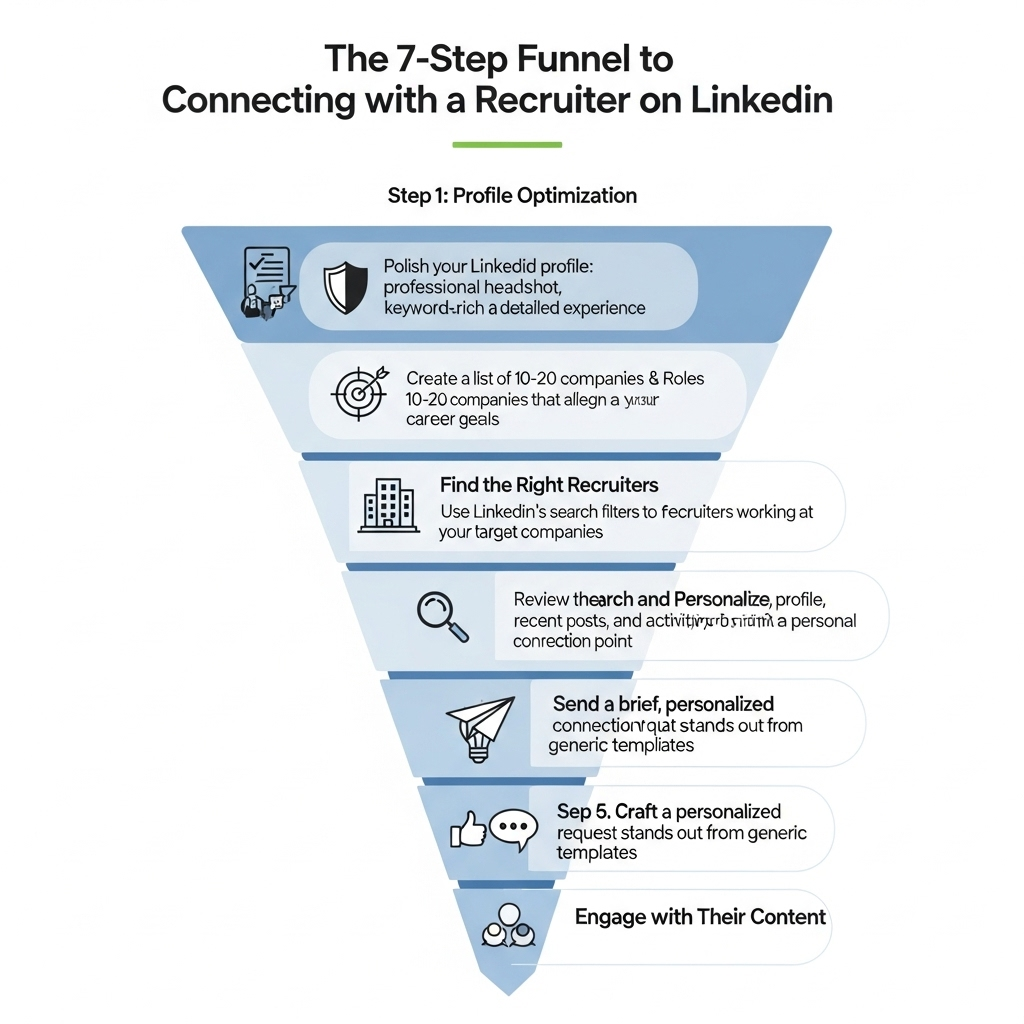How to Find Recruiters on LinkedIn in 2025: A 7-Step Guide

Introduction
Are you sending your resume out, only to hear nothing back? In today's competitive job market, waiting for opportunities to come to you is no longer a viable strategy. To get ahead, you need to be proactive. That starts with connecting directly with the people who have the power to hire you: recruiters. But how do you find them on a platform as vast as LinkedIn?
This guide goes beyond generic advice. We will provide a step-by-step, actionable framework for not only finding the right recruiters but also for building the professional relationships that lead to career-defining opportunities.
H2: Why Your LinkedIn Strategy Isn't Working (and How to Fix It)
Before we dive into the "how," let's address the "why." Many job seekers make the same mistakes: using a passive approach, having an unoptimized profile, and sending generic, uninspired connection requests. The key to success is a targeted, professional, and human-centric strategy.
H2: 7 Steps to Find and Connect with Recruiters on LinkedIn
Here is a proven, step-by-step method to effectively find and engage with recruiters in your industry.
H3: 1. Optimize Your LinkedIn Profile for Recruiter Searches
Before you even think about reaching out, your own profile must be a magnet for recruiters. Remember, recruiters use a powerful tool called LinkedIn Recruiter to find candidates, and it works by searching for keywords in your profile. Over 95% of recruiters use LinkedIn regularly to find candidates Forbes.
Key Optimization Points:
- Headline: Go beyond your job title. Include key skills and the value you offer. E.g., "Senior Software Engineer | Java, Python, AWS | Building Scalable FinTech Solutions."
- About Section: This is your professional story. Use keywords related to your industry and accomplishments.
- Skills & Endorsements: Add at least 5 key skills. This is a major filter used by recruiters.
Call-to-Action (CTA): Before you reach out, ensure your LinkedIn profile is perfectly optimized to catch a recruiter's eye. JobSeekerTools can analyze your profile and resume against specific job descriptions, ensuring you use the right keywords to stand out.
H3: 2. Use LinkedIn’s Search Filters Like a Pro
LinkedIn’s search bar is your most powerful tool.
Numbered List: Step-by-Step Search Process
- Click the search bar at the top of your LinkedIn homepage.
- Type in "recruiter" and add your industry or a key skill. For example:
"recruiter" AND "SaaS"or"technical recruiter" AND "cybersecurity". This is called a Boolean search and helps narrow the results. - On the results page, click the "People" filter.
- Click "All filters" to open a more detailed view. Here you can filter by:
- Title: Use titles like "Recruiter," "Talent Acquisition," "Headhunter."
- Locations: Target recruiters in the geographical area you want to work in.
- Current Company: If you want to work for a specific company, look for their internal recruiters.
H3: 3. Differentiate Between Agency and Corporate Recruiters
Understanding the two main types of recruiters is crucial for a targeted search.
- Corporate Recruiters (Internal Recruiters): They work for one company and hire exclusively for that company. They are your direct path into a specific organization.
- Agency Recruiters (Headhunters): They work for a recruiting agency and hire for multiple client companies. They can present you with a wider range of opportunities across different firms.
H3: 4. Craft the Perfect Connection Request
A generic connection request is a wasted opportunity. You have 300 characters to make a great first impression. Personalize it every single time.
Comparison Table: Bad vs. Good Connection Messages
| Bad Message (Generic & Self-Serving) | Good Message (Personalized & Professional) |
|---|---|
| "I'd like to add you to my professional network on LinkedIn." | "Hi [Recruiter Name], I see you specialize in recruiting for [Industry/Role]. I am a [Your Role] with [X] years of experience and am impressed by your work at [Company Name]. I would welcome the opportunity to connect." |
| "Please look at my profile and let me know if there are any open roles for me." | "Hello [Recruiter Name], I noticed your post about the open [Job Title] role. My experience in [Specific Skill] aligns well with the requirements. I've attached my resume for your consideration and would be happy to connect." |
H3: 5. Engage with Their Content Before Connecting
The best way to get on a recruiter's radar is to engage with their content. Like, comment on, or share their posts. When you do, offer insightful comments, not just "Great post!" This shows you are thoughtful and genuinely interested in your industry.
H3: 6. Follow Up Professionally
If a recruiter accepts your request but doesn't reply immediately, don't be discouraged. Wait a few days, then send a polite follow-up message.
Bulleted List: Follow-Up Best Practices
- Do: Keep it concise and professional.
- Do: Reference your initial connection message.
- Don't: Be pushy or demanding.
- Don't: Follow up more than once or twice.
H3: 7. Build a Long-Term Relationship
Think of networking not as a transaction, but as building a professional relationship. Keep your network warm by occasionally sharing relevant articles or congratulating them on work anniversaries. A strong relationship with a recruiter can pay dividends for your entire career.
Conclusion
Finding recruiters on LinkedIn is not a game of numbers; it's a game of strategy. By optimizing your profile, conducting targeted searches, and sending personalized, professional messages, you move from being a passive job seeker to a proactive career builder. The single most important takeaway is this: authenticity and professionalism will always open more doors than a generic approach.
H2: Visual Guides

The 7-Step Funnel to Connecting with a Recruiter on LinkedIn
This guide outlines the process for effectively connecting with recruiters on LinkedIn.
Step 1: Optimize Your LinkedIn Profile
- Use a professional headshot.
- Write a compelling headline that summarizes your expertise.
- Craft a detailed "About" section showcasing your skills and career goals.
- Keep your "Experience" section updated with your latest achievements.
- Add relevant skills and get endorsements.
Step 2: Identify Target Companies and Recruiters
- Make a list of companies you want to work for.
- Use LinkedIn's search filters to find recruiters at those companies.
- Search for titles like "Recruiter," "Talent Acquisition," or "Hiring Manager."
Step 3: Research the Recruiter
- Review the recruiter's profile to understand their focus.
- Look at their recent activity, posts, and articles.
- Identify any shared connections or interests.
Step 4: Craft a Personalized Connection Request
- Avoid the default "I'd like to connect" message.
- Mention a shared connection, interest, or something you admire about their work.
- Keep it concise and professional.
Step 5: Send the Connection Request
- Send the request at a professional time (e.g., during business hours).
- Double-check for any typos or errors.
Step 6: Engage with Their Content
- Once connected, engage with the recruiter's posts by liking or commenting.
- Share their content if it's relevant to your network.
- This helps you stay on their radar.
Step 7: Send a Follow-Up Message
- After a few days, send a brief follow-up message.
- Reiterate your interest in the company and the types of roles you're seeking.
- Attach your resume if appropriate.
- Thank them for their time and consideration.
Caption: Infographic showing the 7-step process of how to find recruiters on LinkedIn, from profile setup to connection.
Bad LinkedIn Connection Request vs. Good LinkedIn Connection Request
A visually appealing chart comparing a "Bad LinkedIn Connection Request" vs. a "Good LinkedIn Connection Request," with clear callouts for what makes the good one effective.
Bad Connection Request
- Vague and Impersonal: "I'd like to add you to my professional network on LinkedIn."
- No Context: Doesn't explain why you want to connect.
- Self-Serving: Focuses only on your own needs (e.g., "Can you find me a job?").
- Grammatical Errors: Contains typos and poor grammar.
- Demanding: Asks for a favor without building rapport first.
Good Connection Request
- Personalized: "Hi [Recruiter Name], I saw your post about [Topic] and found it insightful."
- Provides Context: "I'm a [Your Profession] with experience in [Your Industry] and I'm impressed by [Company's Work]."
- Highlights Shared Interests: "I noticed we both worked at [Previous Company] and I'd love to connect."
- Clear and Concise: Gets to the point quickly and professionally.
- Polished: Free of any spelling or grammatical errors.
- Offers Value: "I've been following [Company]'s work in [Area] and would be keen to discuss how my skills could benefit your team."
Caption: Comparison chart detailing how to write a good LinkedIn connection request to a recruiter versus a bad one.
H2: Frequently Asked Questions
1. Should I connect with recruiters even if I'm not actively looking for a job? Absolutely. Building a professional network is a long-term strategy. Establishing a relationship with recruiters when you don't need anything is the best way to ensure they think of you when the perfect opportunity arises in the future.
2. What if a recruiter doesn't accept my connection request? Don't take it personally. Recruiters are inundated with requests. They may only connect with candidates who are a direct fit for a role they are actively trying to fill. Continue to engage with their content professionally, and you may still stay on their radar.
3. How many recruiters should I connect with per week? Focus on quality over quantity. Aim for 5-10 highly targeted, personalized connection requests per week rather than 100 generic ones. This will yield much better results.